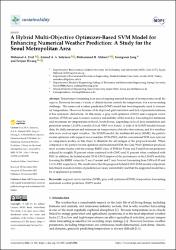| dc.contributor.author | Deif, Mohanad A. | |
| dc.contributor.author | Solyman, Ahmad Amin Ahmad | |
| dc.contributor.author | Alsharif, Mohammed H. | |
| dc.contributor.author | Jung, Seungwon | |
| dc.contributor.author | Hwang, Eenjun | |
| dc.date.accessioned | 2023-10-04T11:45:29Z | |
| dc.date.available | 2023-10-04T11:45:29Z | |
| dc.date.issued | 2022 | en_US |
| dc.identifier.issn | 2071-1050 | |
| dc.identifier.uri | https://hdl.handle.net/11363/5744 | |
| dc.description.abstract | Temperature forecasting is an area of ongoing research because of its importance in all life
aspects. However, because a variety of climate factors controls the temperature, it is a never-ending
challenge. The numerical weather prediction (NWP) model has been frequently used to forecast
air temperature. However, because of its deprived grid resolution and lack of parameterizations,
it has systematic distortions. In this study, a gray wolf optimizer (GWO) and a support vector
machine (SVM) are used to ensure accuracy and stability of the next day forecasting for minimum
and maximum air temperatures in Seoul, South Korea, depending on local data assimilation and
prediction system (LDAPS; a model of local NWP over Korea). A total of 14 LDAPS models forecast
data, the daily maximum and minimum air temperatures of in situ observations, and five auxiliary
data were used as input variables. The LDAPS model, the multimodal array (MME), the particle
swarm optimizer with support vector machine (SVM-PSO), and the conventional SVM were selected
as comparison models in this study to illustrate the advantages of the proposed model. When
compared to the particle swarm optimizer and traditional SVM, the Gray Wolf Optimizer produced
more accurate results, with the average RMSE value of SVM for T max and T min Forecast prediction
reduced by roughly 51 percent when combined with GWO and 31 percent when combined with
PSO. In addition, the hybrid model (SVM-GWO) improved the performance of the LDAPS model by
lowering the RMSE values for T max Forecast and T min Forecast forecasting from 2.09 to 0.95 and
1.43 to 0.82, respectively. The results show that the proposed hybrid (GWO-SVM) models outperform
benchmark models in terms of prediction accuracy and stability and that the suggested model has a
lot of application potentials. | en_US |
| dc.language.iso | eng | en_US |
| dc.publisher | MDPI, ST ALBAN-ANLAGE 66, CH-4052 BASEL, SWITZERLAND | en_US |
| dc.relation.isversionof | 10.3390/su14010296 | en_US |
| dc.rights | info:eu-repo/semantics/openAccess | en_US |
| dc.rights | Attribution-NonCommercial-NoDerivs 3.0 United States | * |
| dc.rights.uri | http://creativecommons.org/licenses/by-nc-nd/3.0/us/ | * |
| dc.subject | support vector machine (SVM) | en_US |
| dc.subject | gray wolf optimizer (GWO) | en_US |
| dc.subject | temperature forecasting | en_US |
| dc.subject | numerical weather prediction (NWP) model | en_US |
| dc.title | A Hybrid Multi-Objective Optimizer-Based SVM Model for Enhancing Numerical Weather Prediction: A Study for the Seoul Metropolitan Area | en_US |
| dc.type | article | en_US |
| dc.relation.ispartof | Sustainability | en_US |
| dc.department | Mühendislik ve Mimarlık Fakültesi | en_US |
| dc.authorid | https://orcid.org/0000-0002-4388-1480 | en_US |
| dc.authorid | https://orcid.org/0000-0002-2881-8635 | en_US |
| dc.authorid | https://orcid.org/0000-0001-8579-5444 | en_US |
| dc.authorid | https://orcid.org/0000-0002-0418-4092 | en_US |
| dc.identifier.volume | 14 | en_US |
| dc.identifier.issue | 1 | en_US |
| dc.identifier.startpage | 1 | en_US |
| dc.identifier.endpage | 17 | en_US |
| dc.relation.publicationcategory | Makale - Uluslararası Hakemli Dergi - Kurum Öğretim Elemanı | en_US |
| dc.contributor.institutionauthor | Solyman, Ahmad Amin Ahmad | |



















